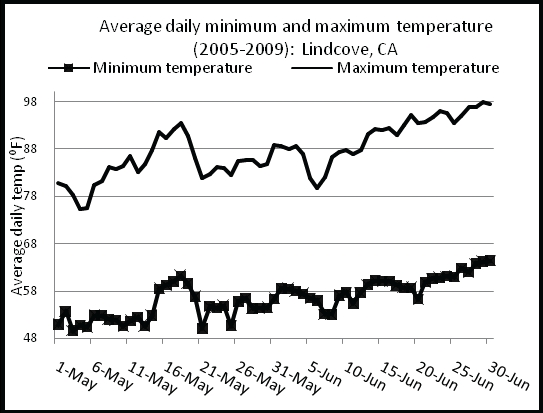- Author: Mark Freeman
Vertebrate pests that have caused damage to citrus trees include rodents and small mammals, large mammals, and birds. Citrus orchards provide food and shelter for a number of these pests, and damage may be severe if the pest resides in the orchard. Damage can occur to the fruit such as rat chewing or bird droppings. Bark damage and tree death can occur from rodents and larger mammals. Damage to irrigation systems such as chewing on hoses can easily be the most expensive damage.
The goals of a successful management program include reducing the number of pest problems and using control methods that are affordable. There are four key points to establishing and maintaining a vertebrate pest management program. First, one must identify the specific damaging species. Second, review all the management control options. Third, one must take action quickly and early, and use the best option that is appropriate for the time of year and the orchard. Fourth, use a monitoring system to detect when re-infestation occurs and thus more controls are needed.
The first key point is identification and observation. Many of the agricultural commissioners’ offices in the counties can help with this problem. In addition, University of California Production Manuals such as almond and walnut have reference material on different pests. It is critical to identify the specific species or type of pest causing damage. You can use direct observations with some pests such as birds or squirrels that are active during the day. With pests that are active at night or tend to hide, one looks for tracks, burrows, or the type of feeding; or one can use traps. With rodents, one can use the size of the incisor marks on plants to help identify the pest. This is also useful on irrigation systems, where one can remove the damaged part and take it to an expert. Traps are also used where trails are established to capture and identify the pest. Pictures, especially close-ups are very useful and can be emailed or sent to experts on the Internet. If you also describe the adjacent habitat such as foothills, streams or rivers, etc., that information will help.
For some pests, there are many possible control options. It is very important to check with the agricultural commissioner’s office as animals vary by protected status and how the animal can be legally controlled. The pest’s life cycle will determine when and if a certain control method can be used. For example, ground squirrels can be controlled effectively with poisoned baits but not in early spring when the animal is feeding on green material. Gophers can be controlled all year with poisoned baits that are applied into the burrows, but are more active when the soil is moist. Habitat modification may be an economical option, as brush piles near an orchard will provide shelter for pests. Biological control such as attracting owls and hawks to an orchard can assist with control, but seldom keeps rodent levels below economic levels.
It is important to act quickly when a control measure is selected. Some vertebrate pests can increase in population quickly, and control is less expensive with lower numbers of pests. Some pests will reside in the orchard, and create a home there. It is much easier to control them when the pests live outside the orchard.
Finally, it is important to have a monitoring system in place after controlling a vertebrate pest so as to detect if the pest is re-entering the orchard. A good record system is important.
Many of the citrus orchards in the San Joaquin Valley (SJV) are located near the foothills on the eastern side. Some of the more common vertebrate pests include gophers, ground and tree squirrels, mice, rats, rabbit, coyote, feral (wild) hogs, and starlings. Rare tree damage has occurred from bear and beaver. There is more new acreage in the SJV planted in the middle of the valley. Those trees will be susceptible to the vertebrate pests already found nearby.
Rodents such as gophers and meadow mice (or voles) feed on plant roots, and can girdle and kill young citrus trees. Occasionally, gophers can kill mature trees, especially if the tree is weakened by other factors such as root rot. Many members of the rat family and deer mice will feed on citrus fruit. The effectiveness of control measures depends on identifying the specific rodent. The Eastern Fox Squirrel (EFS) is a tree squirrel found near big cities in the SJV and throughout the metropolitan areas of Southern California. It has moved to adjacent commercial citrus orchards and will feed on ripe fruit.
Coyotes, rabbits, and squirrels will damage irrigation hoses. By examining the damage, experts can identify the pest. The EFS has caused considerable damage to irrigation systems in some nut crop orchards in the Fresno area.
Larger mammals can be economic pests. Wild hogs will feed on fruit, damage bark, and create large holes or “wallows” on the orchard floor where it is moist. Occasionally, hogs will destroy irrigation hoses. Beavers have destroyed young citrus trees located near streams.
Bird problems have occurred mainly due to large flocks of starlings that nested in orchards at night. The damage resulted from the bird droppings on the fruit.
More information about vertebrate pests can be found here.
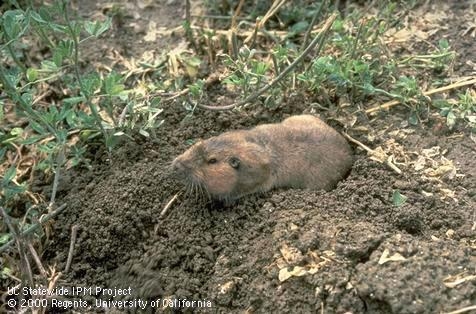
- Posted By: Chris M. Webb
- Written by: Craig Kallsen, Farm Advisor, UCCE Kern County
The three things which seem to be unavoidable during life in the southern end of the San Joaquin Valley are death, taxes, and a considerable price premium in the marketplace for having the earliest of the early citrus for sale. The most robust early market in the San Joaquin Valley of California is for navel orange, however, early lemons and mandarins also reap price benefits. The early citrus market for a given variety may only last for a few weeks or even days.
For navels, the early market usually begins with the first navels picked in mid-October. The chance of a grower being able to profit from this early market requires that the correct planting and cultural decisions be made. To be a player in the early market, the grower has to produce an orange that meets a minimum sugar/acid ratio and the minimum level of color change at the earliest possible date. Pick too early and the fruit receives a red-tag from the Agricultural Commissioner’s Office and may have to be discarded; pick too late and you miss the 100% premium that often goes with the earliest fruit.
To be acceptable to the consumer, this early fruit must be treated with ethylene gas at the packing shed to change the color from yellow-green to orange. Ethylene gas treatment is commonly knows as “sweating” or “gassing” the orange. Generally speaking, the greener the orange, the longer it must be sweated. Sweating the fruit generally reduces fruit size and shelf life and increases problems with the rind and disease susceptibility. There is concern in the citrus industry that the rush to produce the first fruit of the season may compromise fruit quality characteristics such as sweetness and juiciness. A disappointed early-season fruit consumer may not return later in the season to buy more citrus fruit.
Choosing the Right Location
The production of the earliest of the early navel oranges, or the earliest of any of various kinds of citrus in the San Joaquin Valley requires that your trees are located in warm areas. However, very hot mid-summer temperatures are not the key. Temperatures greater than 98°F are probably more harmful than beneficial to citrus production. The earliest citrusmaturing areas in the San Joaquin Valley are south-facing slopes and terraces located along the higher elevations of the citrus belt on the east side of the southern San Joaquin Valley. The Edison area and foothills west of Arvin south and southeast of Bakersfield are examples. These areas tend to retain the insulating layer of fog common in the lower areas of the valley in the coldest months, but break out of the fog in the spring. Less spring fog means more sun and warm temperatures in the early spring, which creates an earlier start in setting and sizing fruit. All else being equal, sandy soils appear to mature fruit earlier than heavier soils.
Choosing the Right Variety
Having the earliest microclimate in the valley does no good if the grower plants late-maturing varieties. As yet, there is no price premium for having the earliest of the late navels, although some growers are cashing in by having the earliest ‘Valencia’ oranges in the spring. Even varieties like ‘Atwood’ or ‘Parent Washington’ will probably be too late for the very early market most years. ‘Fisher’ navels, like the various selections of ‘Thompson Improved’, do have the ability to attain a legal sugar/acid ratio as early as anything else in the Southern San Joaquin, but color is usually delayed. If ‘Fisher’ navels are picked too early the long sweating required to bring up the color usually is associated with substantial green?spotting, especially if the fruit is wet and turgid at picking.
Two navel orange varieties, that have almost disappeared from the San Joaquin Valley, but which still occasionally make an early profit for the owners of the few remaining healthy groves, are ‘Bonanza’ and ‘Tule Gold’. For early fruit producers the ‘Bonanza’ and ‘Tule Gold’ are somewhat frustrating in that unlike the ‘Fisher', they tend to show color very early, but getting the sugar/acid ratio above that required for legal harvest proceeds more slowly. The time lag between the show of acceptable color and the achievement of an acceptable sugar/acid ratio often produces unacceptable levels of anticipation in the grower. All of the early navel trees tend to grow slowly but ‘Bonanza’ and ‘Tule Gold’ trees may be the slowest growing of all. ‘Bonanza’ trees have a problem with what appears to be self girdling, which causes an early decline, although testing conducted a few years ago demonstrated that many trees in these blocks were infected with Stubborn disease. As the groves become older, ‘Bonanza’ and ‘Tule Gold’ trees tend toward the production of heavy loads of small, split, and sunburned fruit.
Two proven producers and similar looking navel oranges for the early market are the ‘Earli-Beck’ and the ‘Newhall’. These two varieties produce a characteristically football-shaped navel. Generally, color and the sugar/acid ratio appear roughly together and usually in the same time-frame as the ‘Bonanza’. The ‘Earli-Beck’ and ‘Newhall’ can achieve a deep, orange-red color and these varieties are prime candidates for the grower who wants to participate in the early market. For a brief period of time years ago, the ‘Earli-Beck’ navel was available in two budlines. One budline contained a viroid and another was free of the viroid. The budline containing the viroid generally appears to produce fruit a few days earlier, however, the growth of the trees is non-uniform and may be associated with an earlier decline of the tree. Although some orchards remain, the budline containing the viroid has not been available for many years.
A relatively new entry (1990s) into the early market is the ‘Fukumoto’. ‘Fukumoto’ navel is early, as early as the ‘Earli- Beck’ and ‘Newhall’ in many years and colors early. This navel is capable of producing a large, well-shaped fruit that responds as well to application of ethylene as any of the other earlymaturing navels. Successfully administered, ethylene produces a very, deep, attractive orange color in these oranges. The ‘Fukumoto’ as with most early navels grows slowly, suckers heavily, suffers from a currently unknown malady called foamy bark rot during hot weather, and the fruit appears more prone to ridging or chimeras. Some evidence suggests that this tree may be exhibiting some growth incompatibility with current rootstocks commonly used in the San Joaquin Valley. Trees that were planted in colder areas and were one or two years of age when struck by a significant frost event may be more susceptible to tree decline as they age.
Choosing the Right Rootstock
The commonly reported sugar/acid ratio consists of a separate measurement of the total soluble solids (i.e. sugar) divided by a separate measurement of the acidity. When a given scion variety is budded onto a wide selection of different rootstocks, significant differences are normally found among the different rootstocks for both, total soluble solids (i.e. sugars) and for acidity. However, significant differences are seldom found for the sugar/acid ratio. The reason for this is that some rootstocks, such as the trifoliates and citranges, will produce a scion fruit with juice high in soluble sugars and high in acidity. Other rootstocks, such as those with lemon heritage, produce fruit low in sugar and low in acids. A high value for soluble solids divided by a high value for acids will produce a sugar/ acid ratio similar to that of a fruit low in sugars and low in acids. Thus, there does not appear to be a rootstock that consistently produces early, high sugar/acid ratios.
Observational evidence suggests that rootstock may affect the development of color in the orange as well. Rootstocks with lemon heritage, for example, such as ‘rough lemon’ or ‘Volkameriana’, when compared in side by side plantings to trees on rootstocks with trifoliate heritage, such as ‘Carrizo’, ‘C-35’ or pure trifoliate types, appear to color more slowly. As an example, in the Edison/Arvin area of Kern County, some of the citranges, like ‘Carrizo, are probably the most common rootstock choice. Rootstocks with lemon heritage, although often producing a more vigorous tree with higher yields, tend to have greater problems with fungal diseases such as those caused by Phytophthora organisms and overall fruit quality. Trifoliates, and some citranges such as ‘C?35’, are more tolerant of Phytophthora, but often become very chlorotic due to a difficulty in absorbing or transmitting micronutrients like iron, zinc and manganese to the scion when grown in the alkaline, boric, and calcareous soils of this area.
Nutrition
Some evidence suggests that earliness is improved by keeping leaf-tissue samples at the low end of the recommended leaf nitrogen range. If nitrogen levels are too low, overall yield and size might be adversely affected, but for maximum earliness without hurting other fruit quality and yield characteristics, leaf nitrogen levels should probably be in the range of 2.2 - 2.4% nitrogen by dry weight in September and early October. Additionally, the bulk of the nitrogen fertilizer for the season should be applied before June 1. Late season nitrogen fertilizations, as well as overall high leaf?tissue nitrogen levels, will likely postpone the date at which a legal sugar/acid ratio is attained. High potassium levels in leaf tissue samples and late season applications of potassium fertilizers will have a similar effect. By maintaining leaf potassium percentages below 0.7 percent and by avoiding foliar applications of potassium, navels should be ready to harvest earlier. Some evidence suggests that high leaf-tissue phosphorous levels decrease fruit acidity, thereby increasing the sugar/acid ratio.
The presence of arsenic in some of the soils and in the well water has been discussed as the reason for the early, early navels in the Edison area, and there is some experimental evidence that arsenic does decrease acidity in the juice of treated trees. Most growers no longer use their high-arsenic well water, which tends to be very high in boron and salts, and use high quality district water from surface sources. Other growers who have never had access to water with high arsenic concentrations have some of the very earliest oranges. Warm locations and the right variety are far more important. Arsenic fertilizer compounds, including sodium arsenate, are prohibited from commercial use.
Leaf-tissue samples on early navels should always include a test for copper. Early navels may require nutritional sprays for copper. Normally, early navels are not treated with brown rotand Septoria?inhibiting copper sprays in the field because they are usually picked before the fall rains. As a result, some groves become deficient in copper, something later navels almost never show due to disease-preventing copper sprays applied in the fall. Treating even the early navels with copper sprays for disease prevention is not a bad idea anyway, since these sprays can reduce the incidence of some post-harvest rots.
Irrigation
Not much is known on the effect of irrigation on earliness. There seem to be as many early navel growers that insist on irrigating close to the day of picking as those who shut the water off or reduce irrigation several weeks before picking. Water stress of short duration can temporarily decrease the amount of water in the orange, and thus increase the concentration of solids (i.e. sugar) in the juice. Less turgid fruit reduces the incidence of green-spotting of the fruit, which may occur when oil glands of the rind are crushed in handling during picking and transportation.
In an experiment conducted from 2006 through 2008 in the extreme southern foothills of the San Joaquin Valley, water stress initiated in August a continuing through harvest in October, resulted in earlier color development of ‘Earli-Beck’ navels, but increased the risk of loss of yield, fruit size, and quality. Care must be taken in removing irrigation from the orchard early because temperatures in October can remain high, and waterstressed trees can result in fruit losing turgor and premature fruit and leaf drop. Often the first rains of the season come in October, so water-stressing the trees prior to harvest, even if desired by the grower in the hopes of rapidly increasing the sugar/acid ratio, is not always an option.
Other Planting and Cultural Tips For Growing Early Navels
Even though early-maturing varieties grow slower than later maturing varieties, the trees should not be allowed to crowd each other. Besides difficulty associated with picking trees that have grown together, and increased pruning costs associated with trying to keep the trees apart, experimental work done in Kern and Riverside County in the late 1960s and early 1970s, demonstrated that trees that are too close together produce smaller fruit with delayed color and lower sugar/acid ratios. Crowding trees together appears to be a better strategy for producing late-maturing citrus fruit.
Insecticidal narrow-range petroleum oils should not be sprayed in the grove within 60 days of the harvest of early navels. Oil sprays tend to interfere with the rate of coloring either on the tree or in the sweating room because early-harvested navels must be sweated for relatively long periods of time to induce the color change from yellow-green to orange. The presence of the oil on the rind in combination with the ethylene gas, can result in some fairly severe rind staining and spotting.
Control of California red and yellow scales using an augmented Aphytis melinus parasitoid wasp release program is, often, less effective when used on early navels in comparison to its use on later-maturing navels. The reason for the reduced efficacy is that Aphytis are not as active during the hot summer months as they are later in the season. At just about the time the Aphytis begin controlling the scale populations in heavily infested groves, it is time to harvest the early navels in October. Long-season navels have at least two additional, and effective, months for the Aphytis to control the California red scale populations.
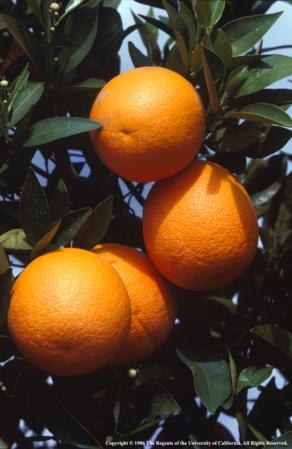
- Posted By: Chris M. Webb
- Written by: Larry Lindgren, Grower and Ben Faber, Farm Advisor
There are many changes going on in the citrus industry and one opportunity is the conversion of an orchard to another variety of citrus. If this is a consideration, then the question becomes one of whether the orchard should be topworked or replanted with new nursery trees. If the trees are healthy and under 20 years of age (it is possible to topwork older trees) and the new scion is compatible with the interstock or rootstock, then topworking can come into production sooner than a new replant. If the planting density needs to be changed or serious soil preparation or a new irrigation system needs to be installed, then replanting might be the preferred choice.
The chance to convert is also dependent on the availability of new trees and budwood. New varieties can often be in short supply. It’s best to make sure that for either option that the material is there. For topworking, T-budding is more conservative of material than stick grafting. If topworking is chosen, then it must be decided whether to graft the scaffold branches or the stump. Stump grafting makes for a lower tree, but scaffold grafting reduces the risk of losing the topworked tree from damage to the graft from birds, pests, wind or frost.
It is often assumed that topworking is cheaper than replanting, but as the following example shows, it probably is not. In Santa Paula, ‘Olinda’ Valencias on ‘Carrizo’ rootstock were converted to scions ‘Allen’ Eureka lemon, or ‘Powell’ late navel. In 1998 and 2000, the ‘Olinda’s were interplanted with either ‘Allen’ on ‘Macrophylla’ or late navel ‘Powell’ or ‘Chislett’ (on either ‘Carrizo or ‘C-35’ rootstocks). The ‘Olinda’s were topworked in 2002 and 2003 to one of the new scions. In a few cases, ‘Allen’ was stump grafted, but most trees were scaffold grafted.
Several steps are required for topworking that will ensure success. These are listed below:
• Get a reputable person to do the work.
• Time of year is critical for grafting. Spring is best.
• Leave a nurse limb.
• Decide to stump or scaffold graft.
o Stump grafting requires only 3 – 4 buds or sticks
o Scaffold grafting requires 2 buds per scaffold. Consider winds since even one-year old unions are very tender.
• Sequence of events
o Line up budwood
o Remove top of tree and stack brush
o Whitewash trunks
o Paint cutoff surfaces
o Insert grafts
o Wrap grafts with plastic tape
o Place white paper bag over grafts and tape in place
Later
o Keep after ants and snails
o Shred brush
o Remove bags when shoots start growing through them.
o Bi-monthly, in first year, brush out water sprouts. Less often in the next 2 years
Much of this work can be contracted with the grafter, who usually assures some level of performance, something like 90% take. It is up to the grower to ensure that pests do not take out the grafts.
The costs of topworking are associated with the costs of the budwood (as much as $3 per tree), the act of grafting (depending on stump or scaffold, $8-10 per tree) and water sprout removal. Sprout removal is six times in year one, eight times in year two and only four times in year three. At a labor rate of $12 per hour, sprout removal costs $7.20 per tree.
A like for like comparison of topworking versus replanting based on 2002 data is shown below.
So in the case of both the lemon and navels it costs a bit more to topwork, but the results are earlier production. Here the topworked trees gain the economic advantage. For example, if cultural costs were $1000 per acre per year (20 by 20 ft. spacing) and, conservatively, two years are saved, the maintenance savings per tree would be $18. In the above study the time advantage appears even greater. Three-year old topworked lemons produce about the same as 6-year old replants. Two year old topworked navels have a significantly larger canopy than six-year old replant navels and appear to have about the same fruit set for the coming year.

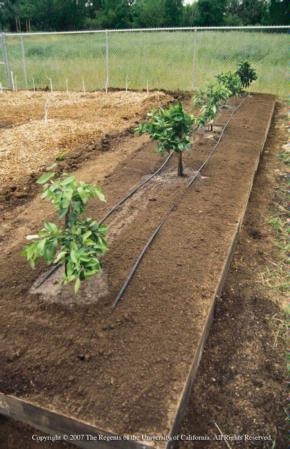
- Posted By: Chris M. Webb
- Written by: Neil O’Connell, Farm Advisor
Deficit irrigation research by Dr.David Goldhamer has yielded some interesting results in navel oranges. In the original trial on mature, vigorous Frost Nucellar navels on a sandy loam soil, applied water was reduced by varying amounts and at different times during the irrigation season depending upon the treatment imposed. Regulated deficit irrigation is applying a fixed % less than the full water requirement of the tree during a specific period in the irrigation season.
The fully irrigated control trees received a volume of water estimated to be the tree water requirements based upon size and current weather conditions –using the current water requirements of a pasture grass (Eto cimis station) multiplied by a crop factor for mature citrus which is 0.65. The objective of the trial was to determine if the volume of applied water could be reduced by varying amounts and at different times during the irrigation season compared to a fully irrigated control without a loss in yield or quality and perhaps improved peel appearance. Measurements were made of fruit growth during the season and of yield and fruit quality at harvest; the amount of water applied with each treatment was measured as well. Research conducted over the years has indicated that citrus was sensitive to reduced irrigation particularly at petal fall and during early fruit development with loss in yield or fruit size.
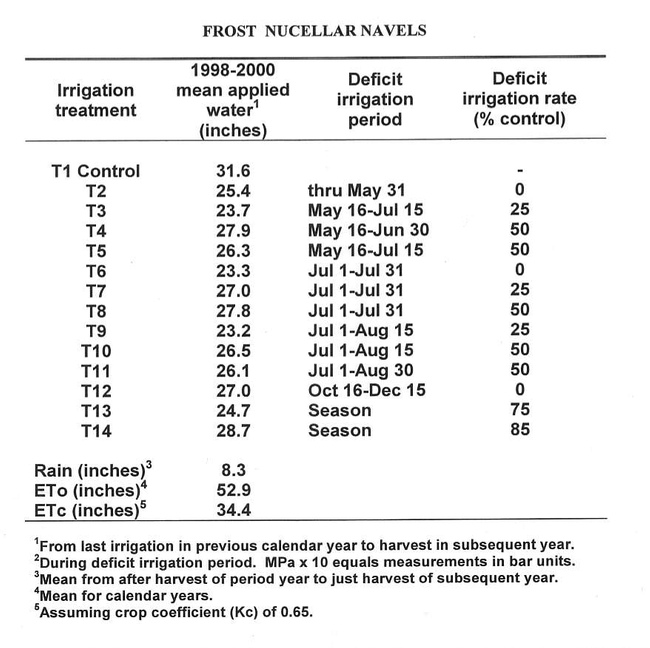
The current study indicated that where deficit irrigation was applied, a slowing in growth rate of the fruit was observed compared to the fully irrigated tree, but when full irrigation was resumed at the end of the treatment period, accelerated growth occurred compared to the control trees. Yield at harvest was not significantly different among any of the reduced irrigation treatments compared to the fully irrigated control trees. There was also no difference in number of fruit per tree or packable cartons among the treatments compared to the control. An additional result was that there was significantly less creasing of the peel in two of the treatments--T2 and T3-- compared to the fully irrigated trees. Both of these treatments imposed stress early in the season and reduced applied water by 6.2 and 7.9 inches, respectively. This equates to 19.6 and 22.8% less applied water than the fully irrigated control. This research demonstrated that less than the full water requirements of the tree can be applied at specific times during the fruit development period under controlled and known conditions without a loss in yield.
Ongoing research on Lane Late navels is being conducted with the object of reducing granulation by regulating fruit size for an optimum fruit size at harvest. Fruit held late for harvest frequently results in a significant portion of the fruit being large. Historically large fruit have a higher percentage of the fruit with granulation. This fruit may be less than optimum size (too large) for current market conditions as well. Based upon the previous regulated deficit irrigation study the object of the current trial is to regulate size based upon imposed stress by applying less than full irrigation during specific periods in the irrigation season that is early, mid and late season stress.
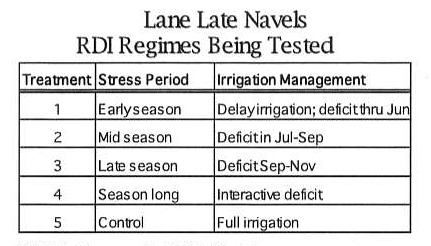
Less water is applied than required by a fully irrigated tree for the period, and growth of the fruit is monitored compared to the fully irrigated tree. Adjustments are made in applied water based upon the growth of the fruit in the stress tree as well as measured tree water status (pressure chamber) compared to the fully irrigated control. The same type of response to the deficit irrigation that occurred with the Frost Nucellar has been observed. A slowing of growth under the deficit irrigation, then accelerated growth with resumption of full irrigation. However, this study imposes stress over longer periods that the previous study and thus, the desired reductions in fruit size at harvest have occurred in all but the T1 treatments. The first year of the study, when fruit loads were relatively high, showed that early season stress reduced granulation (6.5% for all sizes vs. 17% for the control) with no effect on size. Continuous stress reduced both granulation (mean of 3.8 for all sizes vs. 17% for the control) and fruit size. In the second study year with lower fruit loads, there was no reduction in fruit load but fruit size was reduced to a greater extent in the mid, late summer, and continuous stress treatments. This reduced the percentage of unwanted very large size (24 and 32 count) fruit such that revenue to the grower was higher by from $1300 to $3000 per acre, depending on whether 24s and 32s were considered marketable.
Deficit irrigation imposes a level of stress on the tree related to the amount of water that the tree is shorted compared to a fully irrigated tree. The tolerance of the tree to this stress is related to the vigor of the tree, the period in the fruit development cycle, weather conditions, and how long the stress continues, and the magnitude of the stress. Under the conditions of these studies the level of stress imposed is carefully monitored and the deficit irrigation treatments are under known conditions and are carefully controlled. Where conditions are not known by the grower the trees may already be under some stress, the vigor of the trees may not be high; the irrigation system may not be uniform and therefore not delivering the expected volume. Attempting deficit irrigation under these circumstances runs the risk of reducing yield perhaps seriously as well as fruit size.
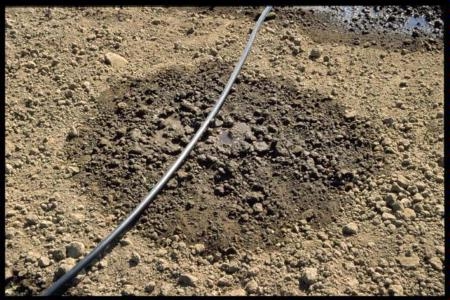
- Posted By: Chris M. Webb
- Written by: Elizabeth Fichtner, Farm Advisor, UCCE Tulare County
The light 2011 olive crop may result in a heavy crop load in 2012. With the prospect of a heavy crop load, it may be wise to consider thinning to reduce fruit quantity and increase fruit size. Management of fruit size may be achieved by pruning and/or chemical thinning.
Why thin your olives?
Larger fruit. Overloaded trees bear small, unprofitable fruit. If a crop is thinned during the fruit’s early growing period, the remaining fruit will grow larger. The larger fruit command a higher price that more than offsets any reduction in total yield. By thinning the crop, you will bring otherwise substandard?sized olives up to canning sizes.
More consistent yearly crops. After a modest crop, shoot growth and prospects for a satisfactory crop the following year are good. In contrast, a heavy crop of olives is followed almost invariably by a light crop.
Early maturity. A moderate crop matures earlier than a heavy crop. An early crop is more likely to get a good reception from the handler, has less competition for harvest labor, is less likely to fall victim to cold weather in the early fall, and ensures a good bloom for the next year.
Lower harvest costs. Olive picking costs are figured on a per-ton basis, so the per-acre harvest costs for a moderate crop are less than for a large crop.
Pruning vs. Chemical Thinning
Pruning removes potential fruit and foliage, stimulating growth which will help minimize alternate bearing. Chemical thinning is achieved with use of the plant growth regulator, naphthaleneacetic acid (NAA). NAA is absorbed into the leaves and fruit and is then translocated to the fruit stems. An abscission layer forms during the first two weeks after NAA application, causing some fruit to drop. Pruning plus chemical thinning is recommended for crop control in Manzanillo; however, chemical thinning is not recommended for Sevillano.
NAA for Olive thinning
NAA Formulation for Olive Thinning. NAA is manufactured in the form of an ammonium salt for commercial use on olive orchards, with 200 g of active ingredient per gallon. This formulation is marketed as Liqui-Stik Concentrate (EPA reg #34704-382) by Platte Chemical Company. The material does not contain wetting agents.
Amount and Timing. The concentration of NAA applied depends on the method used to determine spray timing (full bloom method or fruit size method) and whether a spray oil is used.
Full bloom date method. If you time your spray according to the full bloom date, apply NAA as a dilute spray (300 to 500 gallons per acre 12 to 18 days after full bloom. If applied at 10 days, use a concentration of 100 ppm. Thereafter, increase the concentration by 10 ppm for each day that treatment is delayed. For example, if you spray 15 days after full bloom, use a concentration of 150 ppm. CAUTION: Abnormally cool weather will delay fruit growth. In such a circumstance, use the fruit size method for spray timing.
Fruit size method. If you use the fruit size method, sprays are applied when fruit on the north and south sides of the trees average between 1/8 and 3/16 of an inch. This can be determined by folding a standard 2 x 3-1/2 inch business card in half across the narrow dimension. When 11 to 16 fruit can be placed side by side across the card, it is time to thin. With normal weather, this will usually be between 12 and 18 days after full bloom. It is useful to note the day of full bloom (when approximately 80% of the flowers are open, 10% are unopened and 10% are at petal fall) to allow you to predict spray timing. If you use the fruit size method and spray without a spray oil, apply a concentration of 150 ppm NAA with a wetting agent or spreader-sticker.
Risks and precautions of chemical thinning. The thinning response is dependent on the temperatures shortly following application. Response can vary from no thinning, if temperatures are unusually cool following application, to nearly complete crop removal if temperatures are excessively warm. EPA registration for NAA covers the period from full bloom to 2 1/2 weeks after bloom. Later NAA applications are both illegal and useless. Too early an application will overthin; too late an application will yield unsatisfactory results. An application during bloom will destroy the crop. Hot weather during and following bloom, especially when accompanied by drying winds, can reduce fruit set and make thinning unnecessary. Research has demonstrated that the first two or three days after treatment are the most critical in determining the thinning response. Pay attention to weather forecasts prior to treatment and if forecasted temperatures are significantly warmer or lower than average, (see Figure 1) treatments should be delayed until more normal temperatures return. As the length of time from full bloom increases, the thinning response decreases. NAA should not be used on water stressed trees.
